Abstract
Smart cities leverage digital marketing to promote sustainability and build a distinctive global branding. Despite its growing significance, the role digital marketing in smart city development remains underexplored. This study aims to fill this gap by employing bibliometric analysis of 1908 articles indexed in the Scopus database (2000–2024), using the Bibliometrix R-Studio (version 1.4.1743) and VOSviewer (version 1.6.20). The analysis reveals two thematic clusters: (1) “Digital Innovation and Sustainability”, which emphasizes technologies such as artificial intelligence (AI), the Internet of Things (IoT), and big data for energy efficiency and green urban development; and (2) “Governance and Policy”, which highlights digital marketing’s role in enabling participatory governance, citizen engagement, and inclusive urban policies. Findings underscore that digital marketing is not only a strategic communication channel but also a driver of sustainable urban transformation. By synthesizing insights from urban planning, technology, and sustainability, this paper provides a novel perspective on the intersection of digital marketing and smart cities. The results provide valuable guidance for policymakers, city planners, and researchers to harness digital marketing in promoting sustainability and further develop the smart city concept.
1. Introduction
Sustainable urban development has emerged as a critical response to the increasing pressures on cities to distinguish themselves in a competitive global context, while tackling environmental, social, and economic challenges []. Scholars conceptualize the smart city through multiple dimensions, as shown in the existing literature []. What is clear, however, is that residents of smart cities benefit from urban settings that employ cutting-edge technology and human innovation to boost their overall quality of life []. Τhe global perspective of the smart city concept, along with its innovative governance framework it embodies, highlights the importance of strategic approaches to effectively design and implement smart city initiatives []. Urban branding plays a key role within this framework, bridging technological innovation with the symbolic and experiential identity of cities. It goes beyond traditional marketing by embedding values, stories and images in the physical city, serving both external projection and internal cohesion. In smart cities, digital marketing functions even more intensively, through social media storytelling, real-time engagement platforms, data-driven segmentation, and personalized campaigns that shape and communicate the city’s identity [,]. Place branding helps cities appeal not just to tourists but also to investors and to the skilled labor it wants to attract; it is what makes people want to live in a given place.
Scholars recognize urban branding as the strategic development of a city identity and image through digital, symbolic, and experiential devices in order to distinguish itself amidst a competitive global setting. It is not just about advertising slogans and promotional tours for visitors; it is about embedding their values and stories and experiences into the urban place. When cities integrate urban branding into smart city efforts and digital transformation, it serves as a strategic tool for driving sustainability, citizen engagement, and economic development. For instance, projects such as “Smart Barcelona” or “Amsterdam Smart City” show how digital activities are mobilized to communicate a sense of innovation and the push for inclusivity and sustainability, thereby creating a branded urban image that aligns with general (sustainable) development goals [,]. In this regard, urban branding is not merely a peripheral concept but a key operative tool for articulating and enforcing the vision of sustainable, smart urban future cities.
Within this context, smart cities represent a paradigm shift in urban development based on three connected pillars—technological innovation, sustainability initiatives, and novel governance frameworks. These pillars act in synergy to create urban environments that assure quality of life for their residents [,,].
Technology, the first pillar of the smart city model, plays a fundamental role in its development. Cities depend on comprehensive technological infrastructure to enhance urban systems and enhance the quality of life for their residents [,]. The Internet of Things (IoT) acts as a crucial component of smart city systems, encompassing domains such as transportation, energy management, waste management, and public safety. It enables real-time data collection and evaluation for operational efficiency and responsiveness [,]. Artificial Intelligence (AI) further supports smart city initiatives, given that it emphasizes the scrutiny of key data derived from IoT networks.
The implementation of AI algorithms facilitates predictive analytics, behavioral modeling, and informed decision-making, thereby optimizing urban planning and resource allocation []. Moreover, advanced communication technologies, such as 5G, facilitate uninterrupted connectivity and rapid data transmission across smart urban environments, ensuring reliable communication for both emergency services and intelligent power distribution systems [].
The second pillar, sustainability, plays a central role in smart city design, serving as a means to tackle environmental, social, and economic challenges through creative strategies. Smart cities implement renewable energy systems and energy-efficient solutions to reduce their environmental footprint. [,]. Advancements in technological innovations pertaining to energy management and cybersecurity further promote these initiatives []. Furthermore, IoT-enabled waste management systems, sensors, and advanced data analytics enhance the efficiency of collection routes and recycling procedures, improve performance, and thereby support the development of a circular economy while mitigating environmental impacts [,]. Smart cities also employ AI and the IoT to observe and alleviate the impacts of climate change through early warning systems for natural disasters and adaptive infrastructure designing [,].
The third pillar, governance, plays a critical role in ensuring that technological advancements and sustainability efforts align with the needs of citizens and relevant stakeholders []. Smart city governance focuses on transparency and inclusivity by utilizing digital channels to involve citizens in making decisions to meet the needs of the community and to cultivate trust [,].
Digital platforms and e-governance tools enable prompt decision-making processes by leveraging all technological tools available to significantly optimize resource distribution, improve emergency response mechanisms, and enhance urban planning processes, thereby promoting effective governance [,] though citizen engagement []. As cities transform into intelligent hubs that heavily rely on data systems, considering ethical concerns such as data security, cybersecurity, and potential algorithmic bias is of utmost importance [,]. Moreover, collaboration among the public, private, and non-profit sectors significantly contributes to the smart city initiatives []. Policy frameworks that facilitate innovation, resource allocation, and accountability are crucial for attaining sustainable and inclusive urban environments [,].
At the intersection of these pillars is digital marketing, which acts as an enabler between technology, sustainability, and governance. To adopt a holistic approach to urban development, digital marketing can stimulate innovation, combining technology-oriented activities with socio-economic research to introduce new ways that can make cities smarter. The role of digital marketing is vital in boosting the appeal and sustainability of smart cities, especially through fostering environmental consciousness and encouraging citizen engagement []. Digital marketing utilizes data from the IoT and AI algorithms to implement personalized and significant campaigns to enhance public participation, raise environmental consciousness, and optimize resource utilization, as evidenced by case studies such as Casablanca, Morocco []. Through social media, targeted outreach, and digital storytelling, cities can shape a distinctive global brand while actively promoting public participation in sustainable urban development. Thus, digital marketing not only boosts a city’s visibility and competitiveness but also serves as a catalyst for civic engagement and environmental accountability.
This study aims to comprehensively review, synthesize, and analyze the existing body of literature on digital marketing and smart cities within the context of sustainable urban development. Specifically, the paper seeks to achieve the following goals:
- To investigate the relationship between digital marketing and smart cities within the context of sustainable urban development.
- To offer a data-driven understanding of key themes, trends, and the research network of the field and its dynamics.
- To provide valuable insights for academics, stakeholders, and policymakers so as to augment our understanding of digital marketing and smart cities within the context of sustainable urban development.
To foster innovation and draw knowledge from the fields of behavioral science, management, sustainability, and digital commerce, this study addresses the following three research questions by using a bibliometric analysis:
RQ1: Which are the dominant themes and research trends in the literature on digital marketing and smart cities within the context of sustainable urban development?
RQ2: What are the key countries and researchers in the field, and how do they collaborate on the topic of digital marketing and smart cities?
RQ3: Which key knowledge gaps and future research directions are identified in the literature on digital marketing and smart cities?
The primary contribution of this analysis is twofold. To start with, it explores the intersection of digital marketing and smart cities, shedding light on understudied areas while highlighting the need for further research. This study offers a novel contribution systematically mapping the intersection of digital marketing and smart cities through bibliometric techniques, highlighting the particular significance of digital marketing in advancing and transforming intelligent urban environments. Second, it aspires to share valuable insights and reflections to foster innovation among all involved stakeholders, enterprises, scholars, and policymakers included, and it wishes to contribute to the development of a more environmentally sustainable digital economy, focusing on co-creation.
The remainder of this study is organized as follows. The next section presents the research method. Sections three and fourth analyze and discuss the study’s findings. The final section outlines conclusions and implications for urban planners, city managers, and marketers to implement effective digital strategies that promote and increase sustainable, inclusive, and competitive nature of urban environments.
2. Materials and Methods
Selection of a suitable database was crucial to conduct a detailed and representative bibliometric analysis []. Bibliometrics is based on the quantitative analysis of publication trends, citation data, and research pathways, offering insights into scholarly influence and emerging fields. In contrast, a literature review provides a qualitative synthesis of existing research []. To conduct a comprehensive bibliometric analysis of the relationship between digital marketing and smart cities in the context of sustainable urban development, we selected Scopus as the primary data source. We selected the Scopus database, created by Elsevier in 2004, for its extensive coverage and academic reputation []. Scopus is one of the largest and most exhaustive abstract and citation repositories of the peer-reviewed literature, covering various subject areas, years of publication, document types, and sources from over 5000 publishers worldwide, as well as patents and funding data []. While other emerging AI-oriented databases, like OpenAlex [] and Dimensions [], are available, they lack Scopus’s historical depth and citation metrics [].
The methodological framework consists of two steps. First, we developed a structured selection protocol with the following elements:
- Inclusion criteria: Peer-reviewed journal articles published in English at the final publication stage, containing relevant terms in the title, abstract, or keywords related to both smart cities and digital marketing (or related concepts such as innovation and digitalization).
- Exclusion criteria: Conference papers, editorials, book chapters, and review protocols and articles unrelated to the intersection of urban development and digital marketing or digital transformation.
- Time frame: Publications between 2004 and 2024, reflecting a period of significant growth in smart city research, following the global emergence of the concept in the early 2000s.
- Keywords: Recognizing that the concept of the smart city has evolved significantly over the past two decades—and the earlier literature often referred to the smart city as “intelligent city” or “digital city” [,,]—we intentionally adopted a broad keyword strategy to capture this terminological shift. Our advanced search used variations of the terms: “smart city”, “intelligent city”, “digital city”, “digital marketing”, “innovation”, “marketing”, and “digitalization”. The comprehensive advanced search conducted within the Scopus database is illustrated in Table 1.
 Table 1. Stages of the Scopus database exploration and preliminary results.
Table 1. Stages of the Scopus database exploration and preliminary results.
Next, we analyzed and visualized the bibliometric data using the following two complementary tools:
- VOSviewer: Used for network visualization, such as keyword co-occurrence maps, author collaboration networks, and thematic clustering based on co-citation patterns. The VOSviewer (Visualization of Similarities), illustrated the interrelations among co-citation data, geographic locales, academic journals, and keywords [,].
- Bibliometrix (R package): Used for quantitative analysis, including publication trends, citation counts, keyword frequency, and co-authorship metrics. We used the Bibliometrix R software package [] to further analyze and visualize the evolving research landscape. Pivotal research contributions and theoretical frameworks that have influenced our understanding of digital marketing within the smart cities context were underscored to enhance the identification of gaps within the prevailing body of research.
This dual-tool approach enabled both statistical rigor and visualizations to map the field’s intellectual and thematic breadth. Utilizing VOSviewer (version 1.6.20) and the Bibliometrix RStudio (version 1.4.1743), various indicators including annual number of publications, keyword co-occurrence, keyword clustering, and clustering were used to map digital marketing approaches within smart cities and to monitor global research.
The following section articulates the results of the bibliometric analyses presented herein. It sheds light on the research insights emerging from the study of the interplay between digital marketing and smart cities to foster a better understanding of how these constructs interact across global contexts.
3. Results
Table 2 provides a comprehensive overview of essential statistical data extracted from the Scopus database’s dataset, with an emphasis on research articles pertaining to smart city concepts. The elevated annual growth rate of 33.86% coupled with the relatively small mean age of publications at 4.29 years signifies that the field of smart cities research is both a rapidly expanding and dynamically evolving discipline. The average number of co-authors per publication was 3.27, with a notable proportion of international collaborations standing at 28.09%. The relatively high international co-authorship rate (28.09%) suggests that research on digital marketing and smart cities thrives on cross-border and cross-disciplinary collaboration. This is likely due to the global nature of urban challenges and the need for diverse expertise spanning urban planning, computer science, marketing, and governance. In terms of academic impact, the average citation count of 34.09 implies that while these scholarly articles receive a commendable level of citation, there remains an opportunity for enhanced recognition and influence within the broader academic landscape. The extensive number of keywords, totaling 11.422, reflects the comprehensive scope of research topics encompassed within the smart cities arena, facilitating a diverse array of interdisciplinary inquiries.

Table 2.
Key statistics used in the Scopus database exploration.
Figure 1 delineates the annual scientific output quantified by the number of articles across the years. This figure illustrates the growth in academic publications related to digital marketing and smart cities over the past two decades. A significant acceleration in output is observed after 2015, reflecting increased scholarly and policy interest in digital transformation, sustainability, and urban innovation. This trend suggests the maturing of the field and its alignment with global sustainability and digital governance agendas. This period marks the early stages of research, with few publications and limited exploration of digital marketing and smart urban environments. A sharp increase in scientific output starting around 2010 indicates growing research productivity, potentially attributable to a burgeoning interest in the confluence of digital marketing, smart city initiatives, and sustainability paradigms. The observed growth may also indicate an expanding corpus of the literature engaging with these interrelated themes, as technological advancements and urban development practices continue to progress. In the most recent years, particularly following 2020, a sharp increase in scholarly publications may be associated with continuous advancements in digital technologies, urban planning methodologies, and sustainable practices, which have emerged as pivotal research domains. This trend also aligns with global movements towards digital transformation, sustainable urban development, and a stronger focus on smart cities as key elements of future urban planning.
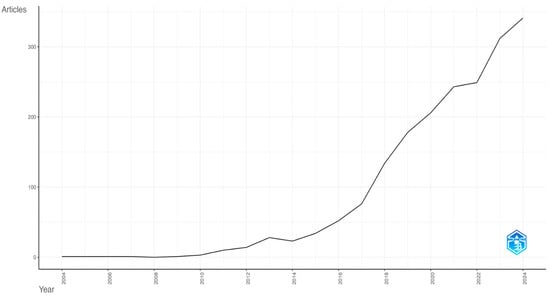
Figure 1.
Annual scientific production on digital marketing and smart cities (2004–2024).
In Figure 2, the geographical distribution of the research conducted according to scholars’ affiliations is illustrated using color coding ranging from light blue (lower output) to dark blue (higher output), based on the number of publications. Researchers affiliated with institutions in China collectively represent the most prolific contributors to the field, which underscores China’s rising impact in the domain of research, particularly in disciplines such as digital technologies, smart city initiatives, and sustainable urban development. Scholars based in the United States also demonstrate considerable scientific publication, holding a prominent role in advancing technology and scientific inquiry, significantly impacting the realms of digital marketing and the evolution of smart cities. Researchers from European countries, including the United Kingdom, Germany, and France, exhibit moderate to elevated levels of scientific output, as indicated by the lighter blue shading. Other regions of interest include researchers based in India, displaying a substantial contribution to publications, as well as academics from Brazil and various regions of Latin America, who are increasingly engaging with the field. In contrast, researchers affiliated with institutions in Africa and much of Southeast Asia contribute less to the literature on digital marketing and smart city initiatives, potentially due to diminished research funding, inadequate infrastructure, or a lack of academic prioritization in these fields. Thus, geographic distribution of publications by authors’ affiliation highlights how national policies and funding models shape academic output in this research topic. However, the underrepresentation of developing regions implies a need for capacity-building and knowledge transfer to ensure global inclusivity in smart urban innovation.
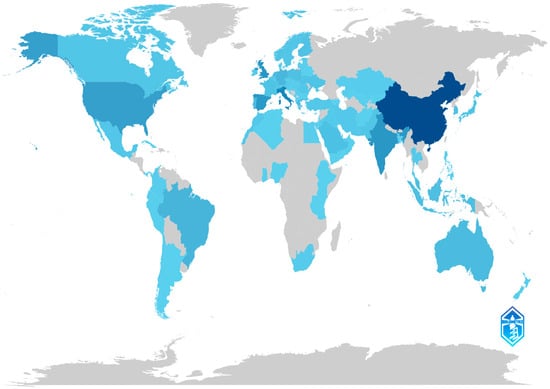
Figure 2.
Geographic visualization of research output by scholars’ affiliation contributing to the research on smart cities and digital marketing.
Figure 3 presents an evaluation of the most prominent authors. More specifically, this figure shows the most prolific authors in terms of the number of published documents. Zhang Y. emerges as the preeminent author, having published the highest document count (19 documents), substantially contributing to the academic field. This author trend may also reflect a long-term focus on China’s digital urbanization strategy. Mora L. and Wang Y. also have a high publication output, totaling 16 and 15, respectively. Deakin M. and Yigitcanlar T. have published 14 and 13 documents, respectively, underscoring their robust presence and ongoing significance within the research community. Chen Y., Liu Y., Wang C., Komninos N., and Wang Z. have each authored 12 documents, illustrating that these scholars are also key contributors to the literature, albeit with a slightly reduced publication output in comparison to the leading five authors. While this metric indicates academic productivity, it does not necessarily equate to scholarly influence or citation impact. For example, although Zhang Y. has the highest number of publications, other authors such as Chen L. may have higher citation counts.
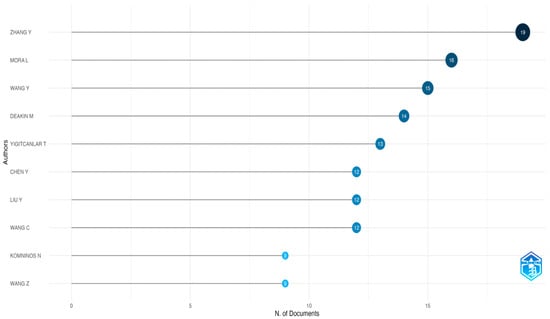
Figure 3.
Most prolific authors in smart city and digital marketing research.
In Figure 4, the authors’ scholarly output over time is visualized to pinpoint the authors who are actively engaged and the temporal spans during which their research received heightened attention, as well as their influence as measured by citation counts. Temporal patterns of productivity indicate responsiveness to funding calls, global crises (e.g., COVID-19), or emerging technologies. Authors with sustained output likely play a role in guiding long-term research programs. These patterns also suggest which scholars are consistently influencing policy and practice. Zhang Y. exhibits a sustained increase in the volume of articles published over the years, with larger circles symbolizing elevated numbers of publications per annum. Zhang Y.’s contributions are likely to be impactful and ongoing, significantly advancing the discipline. Wang Y. similarly demonstrates a consistent upward trend in scholarly production, with numerous active years and marked growth in publications commencing around 2016. The increase in the size of the circles further signifies a continuous output of articles, accompanied by an upsurge in citations (TC per year). Deakin M. and Yigitcanlar T. reveal comparatively stable yet less frequent publication rates in contrast to Zhang Y. and Wang Y. The publication trajectory appears more dispersed; however, citation trends are discernible, featuring peaks in the later years, indicative of pertinent research during those intervals. Chen Y., Liu Y., Wang C., Komninos N., and Wang Z. present a heterogeneous pattern, characterized by a lower overall publication count, yet with a few larger circles denoting specific years of significant impact regarding both articles and citations. Their contributions may be more niche or intermittent relative to their counterparts.
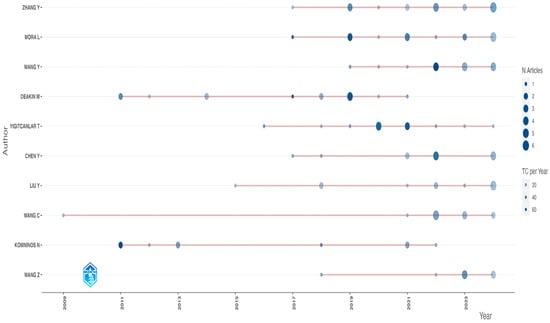
Figure 4.
Trends in the publication activity of key authors over time (2004–2024).
Figure 5 presents the most relevant sources within the research domain pertaining to digital marketing and smart cities, contextualized by sustainable urban development. Sustainability (Switzerland) emerges as the preeminent source, with a substantial corpus of documents (155). Technological Forecasting and Social Change closely follows, with 52 documents. This journal investigates the technological innovations pertinent to urban planning, projecting future trajectories in smart cities, and the societal ramifications of such transformations. Sustainable Cities and Society, comprising 44 documents, underscores the significance of sustainability in urban development, encompassing research that examines smart city initiatives with an emphasis on environmental sustainability. Cities and Smart Cities, each possessing 40 documents, denote a concentrated examination of urban development and digital technologies within the framework of smart cities. The Journal of Urban Technology (27 documents) and IEEE Access (26 documents) mirror the rising significance of technology and innovation in urban contexts and digital marketing. Energies (23 documents), Journal of Cleaner Production (20 documents), and Sensors (Switzerland) (14 documents) are sources that investigate the intersection of clean energy, sustainability, and urban technology. Journals focusing on sustainability and innovation dominate, implying that the field sits at the crossroads of environmental science, urban studies, and digital strategy. This interdisciplinary nature enhances the field’s practical relevance but also challenges researchers to integrate diverse methodologies.
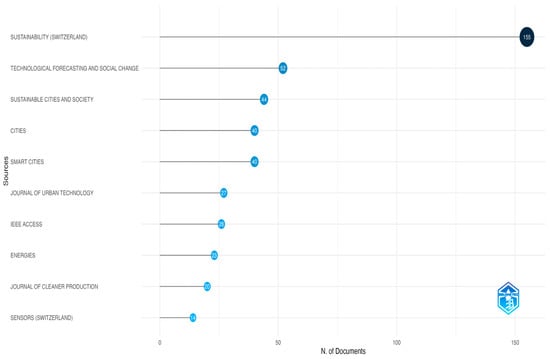
Figure 5.
Leading academic journals to the field of smart cities and digital innovation.
The most globally cited documents, effectively highlighting the scholarly works that have garnered the most extensive global citations, are presented in Figure 6. The majority of references cited by Kitchin [] (1919 citations) have explored the convergence of urban planning and advanced data technologies within the framework of smart cities, emphasizing the transformative potential of data-driven solutions in the reconfiguration of urban landscapes. Batty et al. [] (879 citations) concentrated on the significance of complex systems in the realms of urban planning and smart city evolution, advocating for the application of mathematical models to elucidate urban dynamics. This inquiry was subsequently augmented by Schaffers et al. [] (817 citations), who made substantial contributions to the synthesis of digital technologies and sustainable urban development, offering theoretical constructs for the implementation of ICT solutions in urban planning.
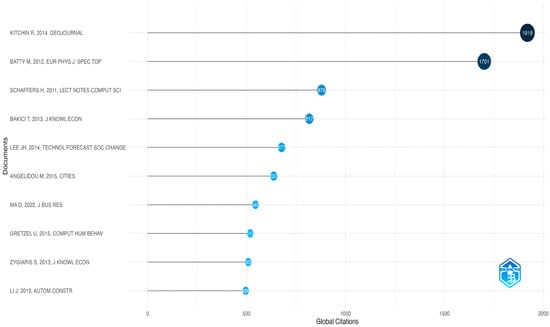
Figure 6.
Articles with the highest citation counts in the dataset [,,,,,,,,].
Subsequently, a cohort of scholars with approximately 500 citations includes Bakici et al. [] (637 citations), who investigated knowledge economies and their implications for smart city strategies, alongside Lee et al. [] (544 citations), who scrutinized the prospective technological ramifications on the infrastructure of smart cities. In the aftermath, Angelidou [] (519 citations) analyzed the integration of digital marketing strategies within the sustainability objectives of smart cities, with particular emphasis on community engagement and the adoption of technology in urban settings. Ultimately, a consortium of studies by Ma and Zhu [] (546 citations), Gretzel [] (519 citations), and Zygiaris [] (503 citations) concentrated on the influence of digital marketing in shaping consumer behavior within smart cities, as well as how technological innovations can enhance urban living while fostering sustainable marketing practices. These scholarly contributions are pivotal for comprehending the intricate interplay between technology adoption, the development of smart cities, and consumer engagement through digital platforms. The most cited works shape the theoretical and conceptual foundations of the field. Their influence shows that the community values frameworks on data-driven governance, ICT integration, and citizen participation. Thus, new contributions must engage with these foundational perspectives or offer significant alternatives.
As represented in the keyword co-occurrence map (Figure 7), the principal focus within the conceptual framework is the phenomenon of smart cities (smart city, smart cities), accompanied by a plethora of associated terminologies dispersed throughout the map. Prominent themes pertinent to smart cities encompass urban development, urban economics, and governance methodologies. This implies that scholarly inquiry in the domain of smart cities is profoundly intertwined with urban planning and economic advancement, emphasizing the implementation of policies and the examination of socioeconomic conditions. The red cluster aggregates terminologies such as the IoT, digital storage, artificial intelligence, blockchain technology, sensors, network security, cloud computing, and cybersecurity. This distinctly underscores the technological dimensions that are critical to the advancement of smart cities, where blockchain innovations and the IoT rule. The green cluster emphasizes sustainability (energy use, pollution, carbon emissions), highlighting environmental concerns. Terms such as energy efficiency, energy utilization, carbon emissions, pollution, energy consumption, and sustainability, illustrated by green clusters, are strategically positioned in proximity to smart cities. This signifies an escalating interest in the paradigm of sustainable smart cities, where energy management, optimization of energy consumption, and the mitigation of carbon emissions occupy a central role. The concept of a green economy is also identified as a critical area within this field. The blue cluster includes terms like governance, citizenship, and e-participation, pointing to the growing role of civic engagement. The focus on governance, the public sector, and the concept of smart citizenship suggests that academic research pertaining to smart cities transcends mere technological considerations, delving into the governance frameworks that oversee and actualize smart city initiatives. The themes surrounding social innovation, citizenship, public engagement, and e-governance indicate a strong interest in inclusive urban planning methodologies. The yellow cluster captures urban development terms, linking infrastructure with digital goals. Terminologies such as intelligent buildings, housing, digital marketing, healthcare, and the automotive sector are integral to the expansive technological and economic applications within smart cities. The thematic clusters represent the field’s intellectual structure. The intersection of governance and technology suggests a rising interest in algorithmic decision-making, digital ethics, and AI accountability in cities. The clustering indicates where integration is the strongest and where silos may still exist, offering direction for future research synergies. Datafication, privacy, literature reviews, and strategic planning denote that data management, data privacy, and the strategic utilization of data within smart cities are significant concerns that stress the ethical dimensions of smart city developments, including considerations regarding data security and user privacy.
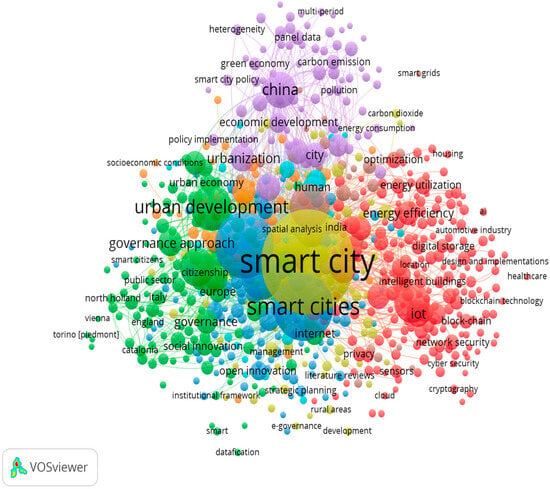
Figure 7.
Keyword co-occurrence map presenting thematic clustering of frequently co-occurring keywords based on content analysis.
Figure 8 presents a tree map diagram that highlights the major thematic sectors in smart city research throughout the examined timeframe. Being the central node, “smart city” acts as a structural component of the map, broadly encompassed by co-occurring concepts including “innovation”, “IoT”, “urban governance”, and “sustainability”. This clustering signifies that the discussion focused on smart cities is gradually being systematized around digital innovation and ecological demands. The importance of the “IoT” and “big data” highlights a technology-centered conceptual framework, whereas the emphasis on “sustainability” and “energy efficiency” points to an alignment with global environmental agendas. Furthermore, the inclusion of “urban governance” and “participation” pinpoints a clear transition towards inclusive and citizen-oriented strategies. These findings align with the previously defined dual pillars of smart city development—technological infrastructure and participatory governance—addressing RQ1 by clarifying the themes that predominantly engage scholarly attention within the field. Consequently, the tree map offers a frequency-based depiction of keywords but also provides insights into the dynamic strategic orientation of smart city initiatives.
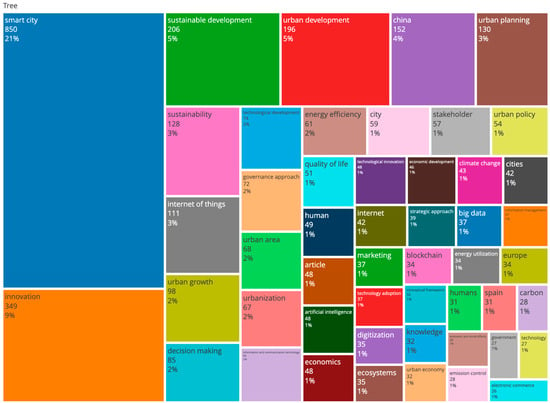
Figure 8.
Tree map presenting the major research trends based on keyword frequency.
According to the annual publication trends of diverse sources (Figure 9), within the field of smart cities and its affiliated areas, the data articulate the rate of articles issued from 2004 to 2024 across various notable sources. A prominent trend observed is the substantial augmentation in scholarly research pertaining to smart cities, especially since the year 2020. This phenomenon signifies a global impetus towards digital urban advancement, sustainability, and the integration of smart technologies as fundamental components of future urban environments. The consistent increase in academic publications associated with Sustainability and Energies denotes that the themes of sustainability, energy management, and the mitigation of climate change are progressively gaining significance within the discourse surrounding smart cities. Academic sources such as Technological Forecasting and Social Change and IEEE Access indicate that technological advancements and their societal ramifications continue to exert a pivotal influence on the development of smart cities, thereby reflecting an increasing interest in the digital transformation of urban landscapes. The persistent growth in scholarly articles from journals like Cities, Sensors, and Sustainability implies a burgeoning interdisciplinary perspective wherein urban planning, digital technologies, and environmental sustainability are increasingly interlinked. Thus, the representation of varied disciplinary journal titles also points to a new interdisciplinary research agenda, involving urban planning, environmental science, and digitalization. These trends suggest that future research efforts in smart cities should, on the one hand, further incorporate progress of technology innovation with the Agenda for Sustainable Development and, on the other, promote interdisciplinary collaborations between academia, engineers, environmentalists, and policymakers.
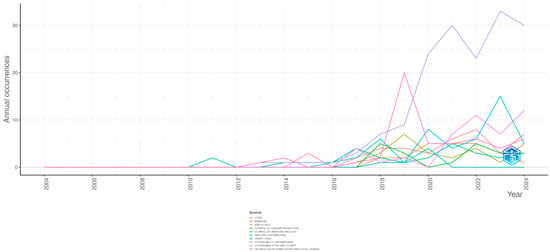
Figure 9.
Evolution of publication trends across top journals (2004–2024).
Figure 10 delineates the evolution of dominant themes within smart city scholarship from the year 2000 to 2024, thereby enabling a longitudinal examination of thematic emergence and decline. During the early 2000s, investigations predominantly focused on foundational concepts such as “digital city” and “information systems”, which underscores a primarily technological perspective. Starting in 2010, the integration of notions such as the “IoT”, “massive data”, and “blockchain technology” points to a shift towards increasingly intricate digital ecosystems. In the recent years post-2020, an impressive tendency is observed toward emphasizing concepts such as “citizen participation”, “platform governance”, “co-creation”, and “digital inclusion”, signaling an intensified focus on the socio-political dimensions of smart city design. This shift represents a broadening of the discipline beyond mere technical efficiency to incorporate values such as inclusivity, transparency, and user-centered urban innovation. Consequently, Figure 10 serves to complement the thematic clusters delineated in Figure 6 and enhances our comprehension of RQ3 by elucidating how academic emphasis has gradually transitioned from systems and sensors to individuals and participatory processes.
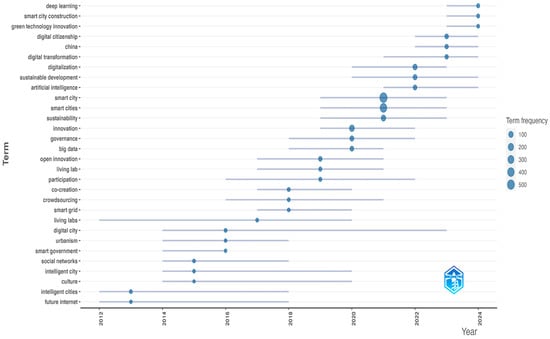
Figure 10.
Trend topics in smart city research between 2004 and 2024.
By harnessing data and employing innovative digital platforms, marketers can facilitate citizen engagement, advocate for sustainable practices, and improve the quality of urban living through cocreation. These results suggest that more research is needed to go beyond a technical assessment of digital tools to an exploration of how digital tools interact with governance, citizen behavior, and sustainability. Digital marketing is a strategic enabler that fosters citizen engagement and co-creation, while governance is very important to achieve inclusiveness, transparency, and accountability. The centrality of these topics suggests a need for greater interdisciplinary blending of urban planning, communication, and policy studies. Indeed, urban branding is understudied; however, the presence of related concepts–digital citizenship and co-creation–indicates a timely chance to envision urban branding also as a participatory and data-driven practice that aligns with smart city aims.
The three-field plot (Figure 11) illustrates the importance of smart cities and digital marketing within the realm of urban development scholarship. China emerges as the leading contributor through affiliated researchers, especially regarding topics related to smart cities and innovation. This observation implies that scholarly inquiries in China are predominantly oriented towards technology-driven urban development and the formulation of smart city initiatives. European states, namely Italy, Spain, Germany, and the Netherlands, are deeply invested in urban development, particularly focusing on sustainable solutions and urban planning frameworks. The United States and India both show significant activity in the areas of urban advancement and smart city innovation, focusing on integrating digital technologies into city infrastructure. The motif of smart cities prevails, with numerous authors contributing to the progressive development and execution of smart city frameworks, encompassing technological, governance, and policy-oriented dimensions. Innovation is intrinsically linked to these themes, reflecting the increasing acknowledgment of the pivotal role that technology and innovation play in the cultivation of sustainable urban environments. Liu Y., Wang Y., and Deakin M. are significant contributors to the discourse on sustainability, smart cities, and urban development, having established their crucial role in propelling these subjects within the global research landscape. Authors such as Komninos N. and Yigitcanlar T. underscore the significance of governance and policy frameworks in the advancement of smart cities.

Figure 11.
Three-field plot linking author affiliations by country, key researchers, and central topics.
Analyzing the nodes in Figure 12, authors affiliated with China (red cluster) are prominently positioned at the center of the network, signifying their preeminent role in the domain of smart city research. The affiliations with other countries, such as India, Japan, and Singapore, imply that researchers from China serves as a pivotal center for technological innovations in smart cities within the Asia–Pacific region. Scholars from the United Kingdom, Italy, and Spain (blue cluster) form another notable cluster, underscoring the significance of European authors in the realm of smart city research. This network likely emphasizes urban development, policy frameworks, and strategies for digital transformation within urban environments. The green cluster, including authors from India as well as Australia and other Asian countries, exhibits robust connections, indicating collaborative efforts in smart city research pertinent to urban expansion, technological integration, and sustainability. The strong presence of Indian researchers highlights the country’s increasing commitment to digital urban solutions and smart city initiatives. The interconnections among researchers affiliated with institutions in countries such as India, China, and Japan (green and red clusters) reveal a growing emphasis on technology and governance for the advancement of smart cities in Asia. In Western Europe, scholars, are actively engaged in collaborative efforts within the spheres of smart city development and digital transformation, with Italy, Spain, and the United Kingdom establishing a central hub for research driven by policy initiatives. Researchers from China and India emerge as a pivotal player in the context of smart cities, with their substantial populations and swift urbanization driving initiatives in digital transformation and sustainability. Although connections with United States-based authors are not prominently featured in the figure, they are likely integral to the broader global network on smart city technology, particularly in domains such as the IoT, AI, and smart governance. Scholars from Brazil, Portugal, and Poland also contribute significantly to smart city research, particularly within Latin America and Eastern Europe, illustrating the global character of digital urban development. Researchers in countries such as Turkey, Pakistan, Mexico, Malaysia, and South Africa are interconnected with others in their respective regions. These countries represent emerging contributors to smart city development and are increasingly enhancing their involvement in global research networks focused on digital technologies and urban sustainability.
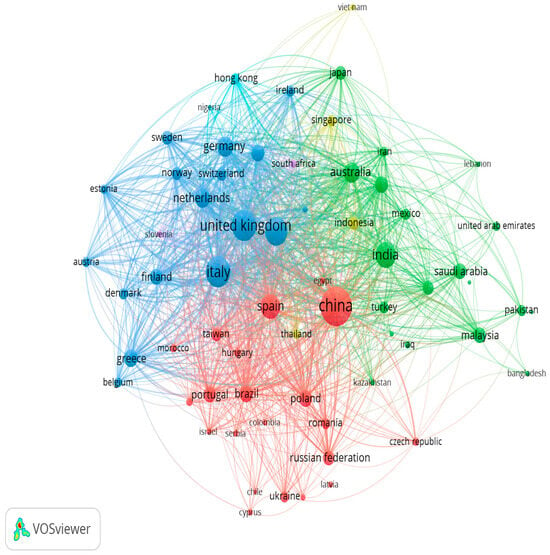
Figure 12.
A network visualization mapping the international collaborations among researchers affiliated with different counties.
The thematic evolution plot (Figure 13) illustrates that major research themes have shifted over two decades. Initially centered on the conceptual frameworks and challenges associated with urbanization, the subsequent period indicates a transition towards pragmatic implementation, highlighting the significance of governance, sustainability, and social inclusion. A clear transition towards implementation can be observed during the years 2015 to 2024, marked by an emphasis on the pragmatic utilization of smart city concepts and the growing importance of governance in ensuring successful outcomes. This evolution suggests that future research must navigate and integrate diverse priorities rather than focus on isolated technological solutions. Sustainability remains a fundamental focus, yet it is progressively being amalgamated with smart city technologies. The emergence of social innovation signifies a developing trend towards inclusive urban development wherein citizens are actively engaged in the formulation of smart urban solutions. These developments underscore the increasing acknowledgment that smart cities encompass not only technological advancements but also the principles of inclusive, sustainable, and effectively governed urban development.
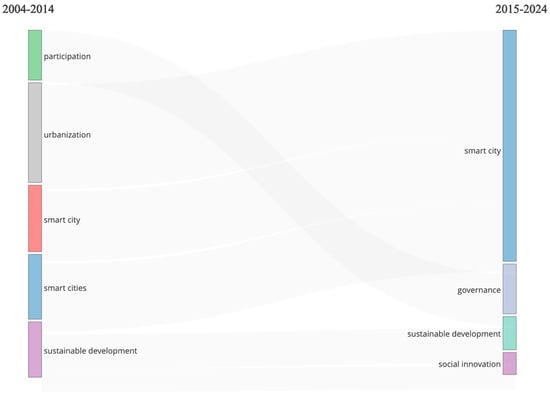
Figure 13.
Thematic timeline of smart city research (2004–2024).
In the thematic map (Figure 14), within the motor themes quadrant, innovation, urban development, urban planning, sustainability, and governance constitute the primary and most extensively explored domains of inquiry, propelling the agendas of smart city initiatives and sustainable development. The prominence of sustainability within the motor themes accentuates the increased urgency surrounding environmental challenges, as smart cities increasingly prioritize eco-friendly technologies, energy efficiency, and sustainable urban policy frameworks. Emerging or declining themes such as the IoT, big data, blockchain, and network security exhibit diminished centrality yet remain significant, with the potential to evolve or be integrated into more expansive smart city frameworks. The emphasis on information management and network security underscores the persistent concerns regarding data governance and privacy, which are becoming critical as an increasing number of urban systems and services undergo digitization. Niche themes represent highly specialized domains of research that concentrate on geographical regions or facets of urban existence and technological integration. The themes of cities and human factors reflect a burgeoning interest in human-centered urban design, wherein the emphasis transitions from technological facets to citizen engagement and the enhancement of quality of life within smart cities. While these themes are essential for the social sustainability of urban innovations, they remain in a developmental phase compared to the broader themes of urban transformation found within the motor themes. Basic themes such as smart city frameworks, sustainable development paradigms, urban expansion, decision-making processes, and energy efficiency are gaining prominence, signifying a transformative trajectory towards the enhancement and refinement of smart city infrastructures. The continued emergence of the smart city as a salient motif, notwithstanding its status as a well-established area of inquiry, implies a persistent emphasis on scalability and the formulation of implementation strategies for intelligent solutions across urban centers globally.
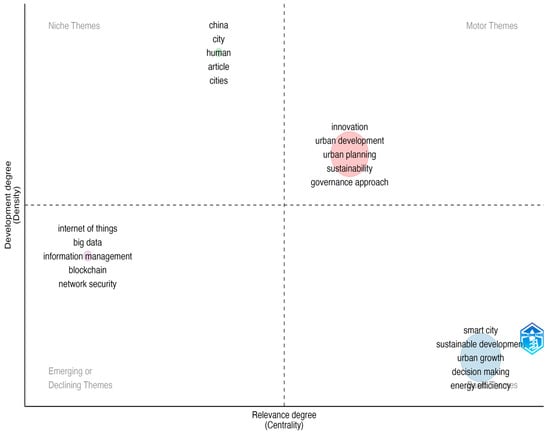
Figure 14.
Emerging research themes classification.
4. Discussion
Based on the results, the dominant themes regarding digital marketing and smart cities within the framework of sustainable urban development are primarily focused on pivotal concepts such as technology, sustainability, and urban development. More precisely, in response to Research Question 1 (RQ1), which examines the dominant themes and research trends in the literature, our bibliometric findings indicate that digital marketing is predominantly conceptualized as an umbrella term in the academic discourse on smart cities. This becomes apparent in the keyword co-occurrence map (Figure 7), where “digital marketing” clusters closely with high-level thematic constructs such as smart city, sustainability, governance, urban development, and innovation rather than with specific digital marketing tools or techniques. Similarly, results (Figure 8 and Figure 14) highlight that digital marketing is part of broad thematic categories that intersect with strategic fields such as urban branding, citizen engagement, and environmental concern.
Of particular significance is the absence of tool-specific terms—such as SEO, email campaigns, social media analytics, content marketing, or mobile advertising—from the top-ranked keywords. This indicates that the literature has yet to systematically disaggregate digital marketing into its underlying components in a systematic manner. While digital marketing is frequently mentioned, it is almost never unpacked into specific tools or addressed in terms of tactical deployment. This observation is further supported by our research strategy and dataset composition, where the inclusion criteria captured documents referencing “digital marketing” or related umbrella concepts in titles, abstracts, or keywords but found relatively few examples of tool-specific terminology. For instance, while “social media” does appear occasionally, it neither forms a dominant cluster nor is it prominent in the list of top authors’ keywords.
This pattern suggests that researchers often use digital marketing as a conceptual bridge, linking digital transformation with citizen participation or innovation rather than examining its individual functions in detail. Having said that, some of the highly cited papers in our dataset do offer qualitative insights into particular digital marketing applications, such as storytelling, participatory campaigns, and data-driven targeting. Such cases, however, are an exception rather than the norm and do not determine the dominant themes emerging from the bibliometric analysis. These trends underscore that digital marketing is approached as a strategic domain rather than analyzed through specific tools. This thematic abstraction, as revealed through our bibliometric results, directly responds to RQ1 by demonstrating how digital marketing is a powerful but broadly defined concept in the research landscape.
The publication and collaboration patterns that emerge from the analysis, in response to RQ2, raise broader questions on the extent to which institutional and regional backgrounds act to inform the research trajectory in this area. The overrepresentation of scholars from countries such as China and the USA presumably does not only mirror a relatively high level of technological development but also infrastructural investments and initiatives tailored to smart infrastructure and digital governance that can play a key role in providing a fertile ground for academic inquiry. But the concentration of research power in a few regions risks skewing the global perspective, particularly when entrepreneurs tend to cluster regionally in collaborative networks. The lower-than-expected participation from developing regions indicates a discrepancy in research capability and research agenda-setting power. Such fragmentation undermines the inclusivity of global smart city conversations, emphasizing the urgent need for increased North–South partnerships and greater contextual diversity.
Key authors with long-standing contributions show that intellectual leadership is concentrated within a small number of authors. While this concentration can strengthen theoretical coherence in the field, it may also reinforce more dominant paradigms at the expense of alternative approaches, notably those based in localized, non-Western urban experiences. Future initiatives could accommodate structures for knowledge sharing and co-authorship which go beyond geopolitical and disciplinary limitations in order to extend the epistemological and practical impact of the field.
Although the research coverage is expanding (RQ3), there remains a lack of theoretical depth and consistency in methods. Much of the literature remains conceptual and often overlooks the behavioral, social, or ethical consequences of digital marketing practices. This gap is especially problematic given the field’s focus on promoting participatory government and sustainability. The lack of robust, empirically grounded models or frameworks to measure the real-world impact of digital marketing strategies on citizen behavior, trust, and inclusion remains a critical limitation.
Although digital marketing is often described as transformational, there is limited research exploring how it works in practice—its tools, mediations, and unintended consequences. Notably, key topics such as data privacy, algorithmic bias, and commercial influence remain underexamined. These blind spots suggest that critical digital studies have yet to become fully incorporated at the level of the research community into the analysis of smart city governance. Furthermore, the field has not capitalized on the potential of interdisciplinary perspectives—drawing from behavioral economics, human–computer interaction, and media studies—to unpack the nature of people’s engagement with digital media in urban sites. Without this integration, the potential of co-creation and citizenship will remain an empty slogan rather than an actual practice. To tackle this, we must go beyond discussing the possibilities of digital marketing to critically examine the shape, operation, and effects of this phenomenon in diverse sociopolitical settings.
5. Conclusions
This study explores how digital marketing contributes to the smart city paradigm within the context of sustainability and urban innovation. By analyzing the growing body of research, this study highlights digital marketing’s vital role in sustainability of smart cities, particularly regarding environmental frameworks, economic vitality, and social dimensions.
Key bibliometric findings support that research on digital marketing and smart cities has experienced rapid growth, particularly after 2015, indicating increasing scholarly and policy interest in the field. The analysis also identified four dominant thematic clusters: digital technology, sustainability, governance, and urban infrastructure. These findings underscore the interdisciplinary nature of the topic and the central role of the implementation of digital marketing strategies in smart cities, particularly within the realms of urban development, governance, and sustainability. Extensively cited research highlights the critical role data analytics, digital platforms, and innovative marketing methodologies in promoting urban sustainability, supporting green policies, and engaging citizens in the co-creation of smart city initiatives. Citation trends show a thematic shift toward digital transformation, smart infrastructure, and sustainability strategies aligned with international sustainable development goals.
Finally, the study identifies two principal research clusters. The first, digital innovation and sustainability, focuses on smart technologies, energy efficiency, and the advocacy for sustainable urban living. The second, governance and policy, emphasizes the relationship between governance and policy, underscoring the pivotal role of digital marketing in advancing policy acceptance, facilitating public interaction, and shaping decision-making strategies that culminate in more innovative and sustainable urban spaces. These clusters epitomize the interdisciplinary nature of the field, blending insights from digital marketing, urban planning, sustainability studies, and governance to formulate integrated frameworks for advancing smart city development.
Despite the growing body of literature, certain research gaps still exist. More specifically, to our knowledge, there is a lack of empirical research examining how digital marketing can encourage citizen co-creation, public engagement, and sustainable behavior. Furthermore, existing studies have limited the scope to technology-focused models, and the social and behavioral aspects are often ignored. The geographical imbalance in research output also underscores the importance of greater representation of scholars from developing countries.
For policymakers, the findings support the potential of digital marketing as a strategic means of driving citizen’s awareness, transparency, and co-designed urban solutions. Urban branding should be regarded as a strategic communication function embedded within smart city initiatives. It can help cities not only market themselves outside, attracting visitors and investment, but also increase their internal cohesion, action-driven co-creation, and trust of citizens. The thematic maps illuminate that “branding” and “participation” are two promising nodes, which are, however, not densely connected—suggesting that these should be integrated. For researchers, this study offers a map that can guide future research. Interdisciplinary collaboration and methodological diversity will be crucial to meet the challenges of digital and sustainable urban development.
6. Limitations and Future Research
Although this study offers a thorough examination of the dynamic interplay between digital marketing, smart cities, and sustainability, it acknowledges certain limitations. The dependence on specific databases and publications in the English language may inadequately represent contributions from non-English-speaking regions and local voices. Additionally, the exclusive use of Scopus-indexed documents may exclude relevant contributions from other databases such as Web of Science, Dimensions, or OpenAlex. Finally, the omission of certain technical perspectives, such as environmental engineering or IoT-based innovations, is a limitation but also provides a fertile ground for future research to incorporate these domains for a more comprehensive understanding of the smart city ecosystem.
Future research should expand data sources and encourage scholars to explore digital marketing’s role in targeting social innovation, behavioral change, and inclusivity in smart cities. Future research efforts should investigate regional disparities in the adoption of digital marketing and smart city initiatives, evaluate the long-term economic and environmental impacts of these technologies, and further examine the role of digital marketing in advancing inclusive and sustainable urban transformation. Urban planners, data scientists, communication specialists, and sustainability researchers must collaborate in order to move toward an inclusive and impactful research agenda. As smart cities continue to evolve and digital eco-systems become more extensive, there is an increasing call for empirical research assessing the extent to which individual digital marketing tools have been effective in promoting sustainability, citizen engagement, and urban competitive advantage. Although the literature has established digital marketing in the context of smart cities, less attention has been dedicated to understanding the how, that is, the instruments, platforms, and contexts enabling digital marketing to contribute to sustainable urban development. Efforts to fill these gaps will need to involve interdisciplinary work across urban studies, digital communication, behavioral science, and sustainability policy. Some differentiation between individual tool strategies—such as internet influencers, digital nudges, and behavioral targeting— could enhance the field and provide actionable advice to urban policymakers and communication strategists.
Author Contributions
Conceptualization, M.B., R.M. and E.S.; methodology, M.B., R.M. and E.S.; software, M.B.; validation, M.B., R.M. and E.S.; formal analysis, M.B.; resources, M.B.; data curation, M.B.; writing—original draft preparation, M.B., R.M. and E.S.; visualization, M.B., R.M. and E.S.; supervision, E.S.; project administration, E.S. All authors have read and agreed to the published version of the manuscript.
Funding
This research received no external funding.
Data Availability Statement
Data are available upon request from the authors.
Acknowledgments
The authors wish to thank the Editor and three anonymous reviewers for their very useful and constructive comments. All errors and deficiencies are the responsibility of the authors.
Conflicts of Interest
The authors declare no conflicts of interest.
References
- Schraven, D.; Joss, S.; De Jong, M. Past, Present, Future: Engagement with Sustainable Urban Development through 35 City Labels in the Scientific Literature 1990–2019. J. Clean. Prod. 2021, 292, 125924. [Google Scholar] [CrossRef]
- Albino, V.; Berardi, U.; Dangelico, R.M. Smart Cities: Definitions, Dimensions, Performance, and Initiatives. J. Urban Technol. 2015, 22, 3–21. [Google Scholar] [CrossRef]
- de Matos, N.; Ramos, C.M.Q. Smart Cities: Operational Concepts for an Elusive Framework. In Advances in Electronic Government, Digital Divide, and Regional Development; Reddy, K.H.K., Roy, D.S., Mishra, T.K., Hussain, M.W., Eds.; IGI Global: Hershey, PA, USA, 2023; pp. 323–338. ISBN 9798369307441. [Google Scholar]
- Joss, S.; Sengers, F.; Schraven, D.; Caprotti, F.; Dayot, Y. The Smart City as Global Discourse: Storylines and Critical Junctures across 27 Cities. J. Urban Technol. 2019, 26, 3–34. [Google Scholar] [CrossRef]
- Angelidou, M. Smart Cities: A Conjuncture of Four Forces. Cities 2015, 47, 95–106. [Google Scholar] [CrossRef]
- Routabi, A.; Bennani, B. Digital Marketing Strategies for Enhancing the Sustainable Attractiveness of Smart Cities in Morocco: The Case of Casablanca. In Advances in Marketing, Customer Relationship Management, and E-Services; Alla, L., Alj, B., Bentalha, B., Eds.; IGI Global: Hershey, PA, USA, 2024; pp. 1–32. ISBN 9798369397756. [Google Scholar]
- Bakıcı, T.; Almirall, E.; Wareham, J. A Smart City Initiative: The Case of Barcelona. J. Knowl. Econ. 2013, 4, 135–148. [Google Scholar] [CrossRef]
- Gretzel, U.; Werthner, H.; Koo, C.; Lamsfus, C. Conceptual Foundations for Understanding Smart Tourism Ecosystems. Comput. Hum. Behav. 2015, 50, 558–563. [Google Scholar] [CrossRef]
- Silva, B.N.; Khan, M.; Han, K. Towards Sustainable Smart Cities: A Review of Trends, Architectures, Components, and Open Challenges in Smart Cities. Sustain. Cities Soc. 2018, 38, 697–713. [Google Scholar] [CrossRef]
- Singh, T.; Solanki, A.; Sharma, S.K.; Nayyar, A.; Paul, A. A Decade Review on Smart Cities: Paradigms, Challenges and Opportunities. IEEE Access 2022, 10, 68319–68364. [Google Scholar] [CrossRef]
- Zhao, F.; Fashola, O.I.; Olarewaju, T.I.; Onwumere, I. Smart City Research: A Holistic and State-of-the-Art Literature Review. Cities 2021, 119, 103406. [Google Scholar] [CrossRef]
- Camero, A.; Alba, E. Smart City and Information Technology: A Review. Cities 2019, 93, 84–94. [Google Scholar] [CrossRef]
- Gracias, J.S.; Parnell, G.S.; Specking, E.; Pohl, E.A.; Buchanan, R. Smart Cities—A Structured Literature Review. Smart Cities 2023, 6, 1719–1743. [Google Scholar] [CrossRef]
- Alahi, M.E.E.; Sukkuea, A.; Tina, F.W.; Nag, A.; Kurdthongmee, W.; Suwannarat, K.; Mukhopadhyay, S.C. Integration of IoT-Enabled Technologies and Artificial Intelligence (AI) for Smart City Scenario: Recent Advancements and Future Trends. Sensors 2023, 23, 5206. [Google Scholar] [CrossRef] [PubMed]
- Chai, Z.; Shah, S.A.; Draheim, D.; Hameed, S.; Rathore, M.M.U. Guest Editorial: Smart Cities 2.0: How Artificial Intelligence and Internet of Things Are Transforming Urban Living. IET Smart Cities 2024, 6, 129–131. [Google Scholar] [CrossRef]
- Ghai, A.S.; Ghai, K.; Cakir, G.K. Generative AI-Enabled IoT Applications for Smart Cities: Unleashing Innovation and Paving the Way for the Future. In Advances in Computational Intelligence and Robotics; Singh, S.K., Tanwar, S., Jadeja, R., Singh, S., Polkowski, Z., Eds.; IGI Global: Hershey, PA, USA, 2024; pp. 222–238. ISBN 9798369323731. [Google Scholar]
- Lytras, M.D.; Alkhaldi, A.; Malik, S.; Serban, A.C. A Holistic Framework for Smart Cities Governance in the Gulf Region: From Hype to Sustainable Impact. In The Emerald Handbook of Smart Cities in the Gulf Region: Innovation, Development, Transformation, and Prosperity for Vision 2040; Lytras, M.D., Alkhaldi, A., Malik, S., Eds.; Emerald Publishing Limited: Leeds, UK, 2024; pp. 1–12. ISBN 978-1-83608-293-4. [Google Scholar]
- Hoang, A.T.; Pham, V.V.; Nguyen, X.P. Integrating Renewable Sources into Energy System for Smart City as a Sagacious Strategy towards Clean and Sustainable Process. J. Clean. Prod. 2021, 305, 127161. [Google Scholar] [CrossRef]
- Razmjoo, A.; Gandomi, A.H.; Pazhoohesh, M.; Mirjalili, S.; Rezaei, M. The Key Role of Clean Energy and Technology in Smart Cities Development. Energy Strategy Rev. 2022, 44, 100943. [Google Scholar] [CrossRef]
- Cortese, T.T.P.; Almeida, J.F.S.D.; Batista, G.Q.; Storopoli, J.E.; Liu, A.; Yigitcanlar, T. Understanding Sustainable Energy in the Context of Smart Cities: A PRISMA Review. Energies 2022, 15, 2382. [Google Scholar] [CrossRef]
- Addas, A.; Khan, M.N.; Naseer, F. Waste Management 2.0 Leveraging Internet of Things for an Efficient and Eco-Friendly Smart City Solution. PLoS ONE 2024, 19, e0307608. [Google Scholar] [CrossRef] [PubMed]
- Narain, S. Integrating Smart City Technologies for Enhanced Urban Sustainability. J. Sustain. Solut. 2024, 1, 13–17. [Google Scholar] [CrossRef]
- Chen, L.; Chen, Z.; Zhang, Y.; Liu, Y.; Osman, A.I.; Farghali, M.; Hua, J.; Al-Fatesh, A.; Ihara, I.; Rooney, D.W.; et al. Artificial Intelligence-Based Solutions for Climate Change: A Review. Environ. Chem. Lett. 2023, 21, 2525–2557. [Google Scholar] [CrossRef]
- Leal Filho, W.; Wall, T.; Rui Mucova, S.A.; Nagy, G.J.; Balogun, A.-L.; Luetz, J.M.; Ng, A.W.; Kovaleva, M.; Safiul Azam, F.M.; Alves, F.; et al. Deploying Artificial Intelligence for Climate Change Adaptation. Technol. Forecast. Soc. Change 2022, 180, 121662. [Google Scholar] [CrossRef]
- Jiang, H. Smart Urban Governance in the ‘Smart’ Era: Why Is It Urgently Needed? Cities 2021, 111, 103004. [Google Scholar] [CrossRef]
- Bastos, D.; Fernández-Caballero, A.; Pereira, A.; Rocha, N.P. Smart City Applications to Promote Citizen Participation in City Management and Governance: A Systematic Review. Informatics 2022, 9, 89. [Google Scholar] [CrossRef]
- Das, D.K. Exploring the Symbiotic Relationship between Digital Transformation, Infrastructure, Service Delivery, and Governance for Smart Sustainable Cities. Smart Cities 2024, 7, 806–835. [Google Scholar] [CrossRef]
- Kaiser, Z.R.M.A. Smart Governance for Smart Cities and Nations. J. Econ. Technol. 2024, 2, 216–234. [Google Scholar] [CrossRef]
- Repette, P.; Sabatini-Marques, J.; Yigitcanlar, T.; Sell, D.; Costa, E. The Evolution of City-as-a-Platform: Smart Urban Development Governance with Collective Knowledge-Based Platform Urbanism. Land 2021, 10, 33. [Google Scholar] [CrossRef]
- Kummitha, R.K.R. Smart City Governance: Assessing Modes of Active Citizen Engagement. Reg. Stud. 2025, 59, 2399262. [Google Scholar] [CrossRef]
- Ahmad, K.; Maabreh, M.; Ghaly, M.; Khan, K.; Qadir, J.; Al-Fuqaha, A. Developing Future Human-Centered Smart Cities: Critical Analysis of Smart City Security, Data Management, and Ethical Challenges. Comput. Sci. Rev. 2022, 43, 100452. [Google Scholar] [CrossRef]
- Bosco, G.; Riccardi, V.; Sciarrone, A.; D’Amore, R.; Visvizi, A. AI-Driven Innovation in Smart City Governance: Achieving Human-Centric and Sustainable Outcomes. Transform. Gov. People Process Policy, 2024; ahead of print. [Google Scholar] [CrossRef]
- Almarri, K.; Boussabaine, H. Critical Success Factors for Public–Private Partnerships in Smart City Infrastructure Projects. Constr. Innov. 2025, 25, 224–247. [Google Scholar] [CrossRef]
- Anthony, B. The Role of Community Engagement in Urban Innovation Towards the Co-Creation of Smart Sustainable Cities. J. Knowl. Econ. 2024, 15, 1592–1624. [Google Scholar] [CrossRef]
- Yigitcanlar, T.; Corchado, J.M.; Mehmood, R.; Li, R.Y.M.; Mossberger, K.; Desouza, K. Responsible Urban Innovation with Local Government Artificial Intelligence (AI): A Conceptual Framework and Research Agenda. J. Open Innov. Technol. Mark. Complex. 2021, 7, 71. [Google Scholar] [CrossRef]
- Narayan, M.; Srivastava, A.K.; Sharma, A. Innovative Strategic Integration of IoT and Digital Marketing for Sustainable Environmental Governance. In Advances in Environmental Engineering and Green Technologies; Hossain, I., Haque, A.K.M.M., Ullah, S.M.A., Eds.; IGI Global: Hershey, PA, USA, 2024; pp. 211–236. ISBN 9798369370018. [Google Scholar]
- Donthu, N.; Kumar, S.; Mukherjee, D.; Pandey, N.; Lim, W.M. How to Conduct a Bibliometric Analysis: An Overview and Guidelines. J. Bus. Res. 2021, 133, 285–296. [Google Scholar] [CrossRef]
- Rabbani, M.R.; Hassan, M.K.; Dejan, A.; Bashar, A.; Hasan, M.d.B. A Bibliometric Analysis of the Review Papers in Finance: Evidence from the Last Two Decades. Rev. Financ. Econ. 2024, 42, 241–257. [Google Scholar] [CrossRef]
- Agarwal, A.; Durairajanayagam, D.; Tatagari, S.; Esteves, S.; Harlev, A.; Henkel, R.; Roychoudhury, S.; Homa, S.; Puchalt, N.; Ramasamy, R.; et al. Bibliometrics: Tracking Research Impact by Selecting the Appropriate Metrics. Asian J. Androl. 2016, 18, 296. [Google Scholar] [CrossRef] [PubMed]
- Research Analytics: Boosting University Productivity and Competitiveness Through Scientometrics, 1st ed.; Cantú-Ortiz, F.J., Ed.; Auerbach Publications: Boca Raton, FL, USA, 2017; reprint in 2018; CRC Press, Taylor & Francis: Oxfordshire, UK; ISBN 978-1-315-15589-0. [Google Scholar]
- Singh Chawla, D. Massive Open Index of Scholarly Papers Launches. Nature 2022. [Google Scholar] [CrossRef] [PubMed]
- Herzog, C.; Hook, D.; Konkiel, S. Dimensions: Bringing down Barriers between Scientometricians and Data. Quant. Sci. Stud. 2020, 1, 387–395. [Google Scholar] [CrossRef]
- Culbert, J.; Hobert, A.; Jahn, N.; Haupka, N.; Schmidt, M.; Donner, P.; Mayr, P. Reference Coverage Analysis of OpenAlex Compared to Web of Science and Scopus. arXiv 2024, arXiv:2401.16359. [Google Scholar] [CrossRef]
- Cocchia, A. Smart and Digital City: A Systematic Literature Review. In Smart City; Dameri, R.P., Rosenthal-Sabroux, C., Eds.; Progress in IS; Springer International Publishing: Cham, Switzerland, 2014; pp. 13–43. ISBN 978-3-319-06159-7. [Google Scholar]
- Park, J.; Yoo, S. Evolution of the Smart City: Three Extensions to Governance, Sustainability, and Decent Urbanisation from an ICT-Based Urban Solution. Int. J. Urban Sci. 2023, 27, 10–28. [Google Scholar] [CrossRef]
- van Eck, N.J.; Waltman, L. Text Mining and Visualization Using VOSviewer. ISSI Newsl. 2011, 7, 50–54. [Google Scholar]
- Wong, D. VOSviewer. Tech. Serv. Q. 2018, 35, 219–220. [Google Scholar] [CrossRef]
- Aria, M.; Cuccurullo, C. Bibliometrix: An R-Tool for Comprehensive Science Mapping Analysis. J. Informetr. 2017, 11, 959–975. [Google Scholar] [CrossRef]
- Kitchin, R. The Real-Time City? Big Data and Smart Urbanism. GeoJournal 2014, 79, 1–14. [Google Scholar] [CrossRef]
- Batty, M.; Axhausen, K.W.; Giannotti, F.; Pozdnoukhov, A.; Bazzani, A.; Wachowicz, M.; Ouzounis, G.; Portugali, Y. Smart Cities of the Future. Eur. Phys. J. Spec. Top. 2012, 214, 481–518. [Google Scholar] [CrossRef]
- Schaffers, H.; Komninos, N.; Pallot, M.; Trousse, B.; Nilsson, M.; Oliveira, A. Smart Cities and the Future Internet: Towards Cooperation Frameworks for Open Innovation. In The Future Internet; Domingue, J., Galis, A., Gavras, A., Zahariadis, T., Lambert, D., Cleary, F., Daras, P., Krco, S., Müller, H., Li, M.-S., et al., Eds.; Lecture Notes in Computer Science; Springer: Berlin/Heidelberg, Germany, 2011; Volume 6656, pp. 431–446. ISBN 978-3-642-20897-3. [Google Scholar]
- Lee, J.H.; Hancock, M.G.; Hu, M.-C. Towards an Effective Framework for Building Smart Cities: Lessons from Seoul and San Francisco. Technol. Forecast. Soc. Change 2014, 89, 80–99. [Google Scholar] [CrossRef]
- Ma, D.; Zhu, Q. Innovation in Emerging Economies: Research on the Digital Economy Driving High-Quality Green Development. J. Bus. Res. 2022, 145, 801–813. [Google Scholar] [CrossRef]
- Zygiaris, S. Smart City Reference Model: Assisting Planners to Conceptualize the Building of Smart City Innovation Ecosystems. J. Knowl. Econ. 2013, 4, 217–231. [Google Scholar] [CrossRef]
Disclaimer/Publisher’s Note: The statements, opinions and data contained in all publications are solely those of the individual author(s) and contributor(s) and not of MDPI and/or the editor(s). MDPI and/or the editor(s) disclaim responsibility for any injury to people or property resulting from any ideas, methods, instructions or products referred to in the content. |
© 2025 by the authors. Licensee MDPI, Basel, Switzerland. This article is an open access article distributed under the terms and conditions of the Creative Commons Attribution (CC BY) license (https://creativecommons.org/licenses/by/4.0/).